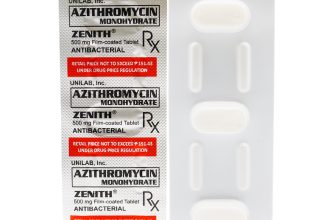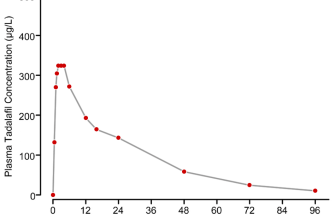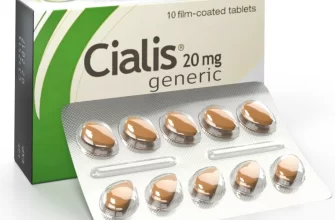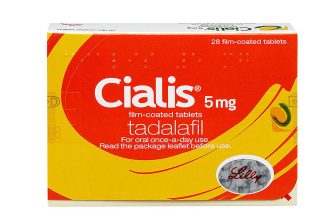Confirm your Cialis coverage by checking your specific Blue Cross Blue Shield plan’s formulary. This document lists covered medications and their associated cost-sharing details. You can typically access your formulary online through your plan’s member portal or by contacting customer service.
Prior authorization may be required. This means your doctor needs to get pre-approval from your insurance company before prescribing Cialis. Prepare for this process by having your doctor submit the necessary paperwork. The specific requirements vary depending on your plan; check your plan details or contact your insurer for precise instructions.
Generic alternatives, like tadalafil, often have lower costs. Discuss these options with your physician to see if they are suitable for your needs and covered under your plan. Exploring generic options can significantly reduce your out-of-pocket expenses.
Consider a mail-order pharmacy for potential savings. Many insurance plans offer discounts on medications purchased through their preferred mail-order pharmacies. This approach can lead to lower costs than purchasing from a local pharmacy.
Remember: This information is for guidance only. Always verify coverage specifics with your Blue Cross Blue Shield plan directly for the most accurate and up-to-date details. Contact your insurer for any questions or concerns about your prescription coverage.
- Cialis and Blue Cross Blue Shield: A Detailed Guide
- Prior Authorization
- Cost-Sharing Variations
- Alternative Medications
- Negotiating Costs
- Cialis Coverage Under Blue Cross Blue Shield Plans
- Factors Affecting Cialis Coverage: Formularies and Tiers
- Understanding Formularies
- Tiered Systems: Cost Implications
- Prior Authorization: A Potential Hurdle
- Generic Alternatives: Cost Savings
- Contacting Your Plan Directly
- Obtaining Prior Authorization for Cialis
- Understanding Your Out-of-Pocket Costs for Cialis
- Alternative Medications and Cost Comparison
- Appealing a Denied Cialis Claim
- Finding Affordable Cialis Options with Blue Cross Blue Shield
- Resources for Further Information on Cialis and Insurance
Cialis and Blue Cross Blue Shield: A Detailed Guide
Check your Blue Cross Blue Shield plan’s formulary. This document lists covered medications and their cost-sharing details. Your plan’s website usually provides online access.
Contact your plan’s customer service. They can verify Cialis coverage, clarify any prior authorization requirements, and explain your specific cost-sharing responsibilities (copay, coinsurance, deductible).
Prior Authorization
Some Blue Cross Blue Shield plans require prior authorization for Cialis. This involves obtaining pre-approval from your insurer before receiving the prescription. Your doctor’s office can usually manage this process. They’ll need to provide medical justification for the prescription. Failure to obtain prior authorization might lead to higher out-of-pocket costs or even prescription rejection.
Cost-Sharing Variations
Cost-sharing varies considerably depending on your specific plan: HMO, PPO, or other. A higher tier plan typically means lower out-of-pocket expenses. Generic alternatives, if available and medically appropriate, will generally reduce your cost.
Alternative Medications
Discuss potential alternative medications with your doctor. If cost is a major concern and your doctor agrees, they may prescribe a similar drug covered by your plan at a lower cost. Remember to thoroughly discuss potential benefits and side effects of each option.
Negotiating Costs
If Cialis is expensive even with insurance, discuss options with your pharmacist. They might have programs or coupons that reduce the final price. Explore manufacturer savings programs as another potential avenue for cost reduction.
Cialis Coverage Under Blue Cross Blue Shield Plans
Coverage for Cialis under Blue Cross Blue Shield plans varies significantly. Your specific plan dictates coverage; therefore, check your policy documents or contact your plan administrator for precise details.
Generally, Cialis is covered if prescribed for erectile dysfunction or benign prostatic hyperplasia (BPH), but only when meeting specific plan criteria. These may include prior authorization, step therapy (trying less expensive medications first), or quantity limits.
Formulary inclusion is key. Cialis may be on your plan’s formulary, meaning it’s covered at a negotiated price. However, if it’s not, you’ll likely pay a much higher cost.
Your out-of-pocket expenses depend on factors like your deductible, copay, and coinsurance. High deductible plans might require a larger upfront payment before coverage kicks in.
For the most up-to-date information about your coverage, use your plan’s online member portal or contact customer service directly. They provide the most accurate details regarding your specific benefits and potential costs. Don’t hesitate to clarify any uncertainties about your prescription drug coverage.
Factors Affecting Cialis Coverage: Formularies and Tiers
Check your Blue Cross Blue Shield plan’s formulary. This document lists covered medications and their placement within the plan’s tiered system. Cialis’s tier directly impacts your out-of-pocket cost.
Understanding Formularies
A formulary is essentially a drug list. Insurance companies negotiate prices with pharmaceutical manufacturers, determining which drugs they’ll cover and at what cost. The formulary’s contents and pricing can change periodically; always review your current formulary to confirm Cialis’s status.
Tiered Systems: Cost Implications
Most plans use a tiered system. Tier 1 typically includes the least expensive generic drugs, while higher tiers (Tier 2, Tier 3, etc.) contain brand-name medications or preferred specialty drugs. Cialis, as a brand-name drug, usually resides in a higher tier, leading to greater patient cost-sharing. Your copay, coinsurance, or deductible will vary depending on Cialis’s tier assignment.
Prior Authorization: A Potential Hurdle
Some plans may require prior authorization before covering Cialis. This involves obtaining your doctor’s approval through a pre-approval process. This extra step adds time to the prescription process; plan accordingly. Contact your plan’s customer service or pharmacy benefit manager (PBM) for specific requirements.
Generic Alternatives: Cost Savings
Consider exploring generic alternatives if available. Tadalafil, the generic equivalent of Cialis, is often available at a lower cost and may be placed in a lower tier, leading to reduced expenses. Discuss options with your physician to determine the suitability of generic options.
Contacting Your Plan Directly
For definitive answers on Cialis coverage and specific cost information, contact your Blue Cross Blue Shield plan’s customer service department or check your online member portal. They can provide the most accurate and up-to-date information related to your specific policy.
Obtaining Prior Authorization for Cialis
Contact your Blue Cross Blue Shield plan directly. Their customer service number is readily available on your insurance card or their website. Prepare your prescription information and your policy details.
Expect to provide specific information. This includes your doctor’s prescription, your diagnosis, and details about alternative treatments considered.
You might need to complete a prior authorization form. Your insurance provider will guide you through this process, providing the necessary forms and instructions. Follow instructions carefully; incomplete forms delay approvals.
Some plans require pre-authorization for specific dosages or only for certain indications. Check your formulary to understand your plan’s specific requirements regarding Cialis coverage. Your doctor can help you navigate this.
Typical processing time varies. Inquire about the estimated timeframe for your plan’s prior authorization process. Follow up if you haven’t received an update within the anticipated timeframe.
| Step | Action |
|---|---|
| 1 | Contact Blue Cross Blue Shield |
| 2 | Gather necessary information |
| 3 | Complete forms |
| 4 | Check your formulary |
| 5 | Follow up on your request |
Remember, proactive communication and complete information facilitate a smoother process.
Understanding Your Out-of-Pocket Costs for Cialis
Check your Blue Cross Blue Shield plan’s formulary to determine Cialis’s tier. This dictates your cost-sharing.
Tiered plans typically have different co-pays or coinsurance for medications. A higher tier means a higher cost to you. Generic alternatives, if available, usually fall into lower tiers and are cheaper.
Your out-of-pocket cost depends on several factors: your plan’s deductible, your copay, and your coinsurance. If you haven’t met your deductible, you’ll pay the full cost of Cialis until you reach that threshold. After meeting your deductible, you’ll pay your copay or coinsurance, depending on your plan.
Your plan’s maximum out-of-pocket limit protects you from unlimited expenses. Once you reach this limit, your insurance will cover 100% of your prescription costs for the remainder of the year.
| Factor | Impact on Cost |
|---|---|
| Plan Tier | Higher tier = higher cost |
| Deductible | Pay full price until met |
| Copay | Fixed amount per prescription |
| Coinsurance | Percentage of the cost you pay |
| Out-of-Pocket Maximum | Limits your total yearly cost |
Contact Blue Cross Blue Shield directly or check your online member portal for specific cost details regarding your plan and Cialis. They provide the most accurate and up-to-date information.
Consider exploring manufacturer coupons or patient assistance programs. These can significantly reduce your costs.
Alternative Medications and Cost Comparison
Consider Tadalafil (generic Cialis) as a cost-effective alternative. Many pharmacies offer significant discounts on generic medications.
Here’s a comparison based on average US prices (prices vary widely by location and pharmacy):
- Cialis (brand name): $70 – $100 per 30-tablet prescription (20mg)
- Tadalafil (generic): $20 – $50 per 30-tablet prescription (20mg)
Savings can be substantial depending on your insurance coverage. Check your formulary for specific pricing.
Other PDE5 inhibitors, like Vardenafil (Levitra) and Avanafil (Stendra), may also be suitable alternatives. Their pricing is comparable to Tadalafil, often slightly higher or lower, depending on the pharmacy and dosage.
- Consult your doctor: Discuss these alternatives to determine the best medication and dosage for your individual needs and health history. This is crucial to ensure medication safety and effectiveness.
- Compare pharmacy prices: Use online pharmacy comparison tools or call your local pharmacies to obtain the most current pricing information. Many offer prescription savings programs.
- Explore manufacturer coupons and savings cards: Some manufacturers provide discounts on their medications. Check their websites for available options.
- Consider a 90-day supply: Purchasing a larger quantity may reduce the per-pill cost in some cases.
Remember, always prioritize your health and safety. Consult your physician before starting or changing any medication.
Appealing a Denied Cialis Claim
Review your denial letter carefully. Identify the specific reason for the denial. This is crucial for crafting your appeal.
Gather supporting documentation. This includes your prescription, doctor’s notes explaining medical necessity, and any prior authorizations obtained.
Contact Blue Cross Blue Shield directly. Explain the situation clearly and concisely. Have your member ID and claim number readily available.
If the initial phone call doesn’t resolve the issue, submit a formal written appeal. Clearly state the reason for the appeal and provide all relevant documentation.
Follow up on your appeal in writing or by phone after a reasonable time. Keep detailed records of all communication.
Consider contacting your physician. They can provide additional documentation supporting your need for Cialis.
If your appeal is still denied, explore your state’s insurance appeals process. Many states have external review programs.
Remember to keep copies of all correspondence. This protects your rights throughout the appeals process.
Finding Affordable Cialis Options with Blue Cross Blue Shield
Check your Blue Cross Blue Shield formulary. This document lists covered medications and their associated tiers. Cialis’s tier determines your out-of-pocket cost.
Explore different Cialis formulations. Generic tadalafil is often significantly cheaper than brand-name Cialis. Your plan might cover the generic, reducing your expenses.
Utilize your plan’s mail-order pharmacy. Mail-order pharmacies frequently offer discounted prices on prescription drugs, potentially leading to savings.
Consider using a Blue Cross Blue Shield preferred pharmacy. These pharmacies have negotiated lower prices with your insurance provider, resulting in lower costs for you.
Negotiate a payment plan with your pharmacy. If immediate payment is difficult, inquire about payment plans to manage costs.
Contact Blue Cross Blue Shield customer service. They can provide personalized information about your plan’s coverage and cost-saving options for Cialis.
Explore manufacturer savings programs. Pharmaceutical companies often offer programs to assist patients with medication costs. Check the Cialis website for available options.
Compare prices across pharmacies. Prices for the same medication can vary among different pharmacies, even those in network. Shop around to find the best price.
Resources for Further Information on Cialis and Insurance
Contact Blue Cross Blue Shield directly. Their customer service representatives can verify your coverage specifics and explain how your plan handles Cialis prescriptions. You can find their contact information on their website.
Check your member handbook or online portal. Your plan’s details, including formulary information (a list of covered medications), are available through these resources. Look for the section on prescription drug coverage.
- Blue Cross Blue Shield’s Website: Explore the website’s sections dedicated to prescription drug coverage and formularies. These often have search tools to check medication coverage.
- Your Pharmacy’s Website or App: Many pharmacies provide online tools that allow you to check your insurance coverage before filling a prescription.
- Your Employer’s Benefits Department: If your insurance is provided through your employer, their benefits department can offer assistance and clarification.
Consider using a prescription savings program. These programs can help lower the cost of medications, even if they aren’t fully covered by insurance. Numerous independent programs exist; research to find one suitable for your needs.
- GoodRx: A popular website and app that provides price comparisons and coupons for prescription medications.
- SingleCare: Another well-known provider of prescription discount cards.
If you encounter difficulties, consult a pharmacist. They can provide guidance on navigating insurance coverage and exploring cost-saving options.








